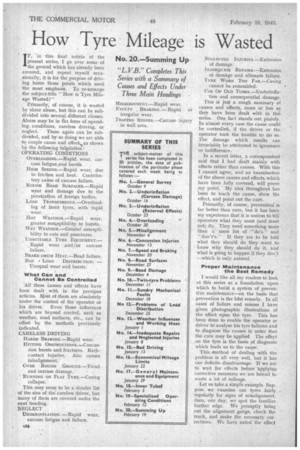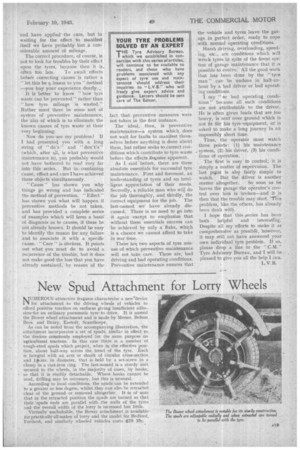How Tyre Mileage is Wasted
Page 20

Page 21

If you've noticed an error in this article please click here to report it so we can fix it.
No. 20.—Summing Up L.V.B." Completes This Series with a Summary of Causes and Effects Under Three Main Headings
IF, in this final article of the present series, I go over some of the ground which has already been covered, and repeat myself occasionally, it is for the purpose of driving home those points which need the most emphasis. To re-arrange the subject-title "How is Tyre Mileage Wasted?"
Primarily, of course, it is wasted by sheer abuse, but this cari be subdivided into several different classes. Abuse may be in fha form of operating. conditions, careless driving, or neglect. These again can be sub divided, and by so doing we are able to couple cause and effect,eas shown by the following taliplation: OPERATING CONDITIONS
OvEstwarsiNG.Rapid wear,
case fatigueeand bursts.
HIGH SPEEDS.—Rapid wear, due
to friction and heat. Contribu tory cause of carcase failure.
ROUGH ROAD SURFACES .—Ra pid
wear and damage due to the penetration of foreign bodies.
LOAD TasNsFERExcE.—Overload
ing of front tyres, with rapid
car HOT WEATHER.-=Rapid wear, greater susceptibility to bursts. Wrr WEATHER.—Greater susceptibility to cuts and punctures. , UNSUITABLE TYRE EQUIPMENT.— ,Rapid wear And/or carcase failure.
BRAKE-DRUM HEAT . —Bead failure. BAD • LOAD DISTRIBUTION. — Unequal wear and bursts.
What Can and .
Cannot Be Controlled
'All these 'causes and effects have been dealt with in the previous articles. Most of theta are absolutely under the control of the operator or his driver. Even those influences which are beyond control, such as weather, road surfaces, etc., can be offset by the methods previously indicated.
CARELESS DRIVING •
HARSH BRAKING.—Rapid wear.
HITTING OBSTRUCTION'S . .Concussion bursts and fractures. Kerbcontact injuries. Also causes misalignment.
OVER ROUGH ' GHOUND.—Tread
and 'carcase damage. . ,
' RUNNING ON FLAT TYRE. —Casing
collapse.
This may seem to be a slender list of the sins of the careless driver, but many of them are covered under the next heading.
NEGLECT
1..INDERINFLATION. —Rapid wear, carcase fatigue and failure.
MrsauGsirviENT.—Rapid wear.
' FAULTY BRAKING. — Rapid or irregular wear.
TRAPPED SION ES . —Carcase injury in wall area. •
NEGLECTED INJURIES,.--EXtCIISiOH
of damage
IN ADEQUATE REPAIRS—Extension
of damage and ultimate failure. TYRE WORN TOO FAR—Casing Cannot be remoulded.
USE OF OLD TUBES.—ThICIeTiilfla tion and consequential damage. This is just a rough summary of causes and effects, snore or less as they have been dealt with in this series. One fact stands out plainly. In almost every case the cause could be controlled, if the driver or the operator took the trouble to do so. The damage which results can invariably be attributed to ignorance or indifference.
In a recent letter, a correspondent said that I had dealt mainly with effects rather than causes. With this I cannot agree, and an 'examination of the above causes and effects, which have been fully covered, will prove my point.' .My idea throughout has been to teach the cause, show the effect, and point out the cure.
Primarily, of course, prevention is far better than cure, but it has been my experience that it is useless to tell operators what they must (and must not) do. They heed something more than a mere list of " do's " and " don't's." ' If they are to be told what they should do they want to, know why they should do it, and what is going to happen if they don:t —which is only natural.
Proper Maintenance the Best Remedy
I would like all my readers to look at this series as a foundation upon which to build a system of preventive maintenance—on the basis that prevention is the best remedy. In all cases of failure and misuse I have given photographic illustrations of the effect upon the tyre. This has been done to enable the operator or driver to analyse his tyre failures and to diagnose 'the causesin order that the cure may be applied The effect on the tyre is the basis of diagnosis which leads us to the cause.
This method of dealing with the problem is all very well, but it has one definite disadvantage. If we are to wait for effects before 'applying corrective measures we are bound to waste a lot of mileage.
Let us take a simple example. Suppose we examine our tyres fairly regularly for signs of misalignment,
then, one day, we spot the familiar feather edge. We .promptly bring
out the alignment gauge, check the track, and make the necessary corrections. We have noted the effect and have applied the cure, but in waiting for the effect to manifest itself we have probably lost a considerable amount of mileage.
The correct procedure, of course, is not to look for troubles by their effect upon the tyres, because then it is, Often too late. To await effects beforh correcting causes is rather a " let.this be a lesson to you " Method —you buy your experience dearly. , It is better to know "how tyre waste cap be prevented' rather than "how tyre mileage is wasted."
Rather must there be sonic sort of system of preventive maintenance, the aim of which is to eliminate the known causes of tyre waste at their very beginning.
Now do you-see my problem ? If I had presented you with a long
string of " do's " and " donTs " (which, after ail, is *hat preventive maintenance is), you probably would
not have bothered to read very far into this series. But incombining cause, effect and cure I have achieved three objects simultaneously.
" Cause " has shown you why things go wrong and has indicated the method of prevention. "Effect" has shown yon what will happen if preventive methods be not taken, and has provided a complete series of examples which will form a basi of diagnosis as to causes-, if these be not already known. It should be easy to identify the reason for any failure and to associate it with a specific cause. " Cure " is obvious. It points out what you must do to avoid a recurrence of the trouble, but it does not make good the loss that you have already sustained, by reason of the fact that preventive measures were not taken in the first instance. • The ideal, then, is preventive maintenance—a system which does not wait for faults to manifest themselves before anything is done about them, but rather seeks to correct conditions which contribute to tyre waste before the effects Become apparent.
As I said ' before, there are three absolute essentials for successful tyre maintenance. First and foremost, an understanding of tyres and an intelligent appreciation of their needs. Secondly, a reliable man who will do the job thoroughly, and thirdly, the correct equipment for the job. The last-named we have already discussed. There is no need to go into it again except to emphasize that without these essentials success can -be achieved by only a fluke, which is a chance we cannot afford to take in war time.
There are two aspects of tyre misuse of which preventive maintenance will not take care.' These are, bad driving and bad operating conditions. Preventive maintenance ensures that the vehicle and tyres leave the garage in perfect order, ready to cope with normal operating conditions.
Harsh driving, overloading, speeding, etc., are conditions which will wreck tyres in spite of the finest system of garage maintenance that it is possible to evolve. All the good work that has been done by the 'tyre man" can be undone in half-anhour bya bad driver or bad operating-conditions.
I say " er bad operating conditions" because all such conditions are not attributable to the driver. He is often given loads that are ,too heavy, is sent over ground which is not fit fer his tyre -equipment, or is asked to make a long journey in an impossibly short time.
Thus, the operator must watch three points : -(1) his maintenance system, (2)his driver, (3) his conditions of operation.
The first is easy to control; it is simply a matter of supervision. The last point is also fairlysimple to watch. But the driver is another matter altogether. So soon as he leaves the garage the operator's control over him is broken—and it is then that the trouble may start. –15-is problem, like the others, has already been dealt with.
hope that this ,series has been both helpful and interestrng.' Despite all my efforts to make it as comprehensive as possibre, however, it may still not have answered your own individual tyre problem. If so, please drop a line to the "C.141." Tyre Advisory Bureau, and I will be pleased to give you all the help I can.
L. V. B.




















































